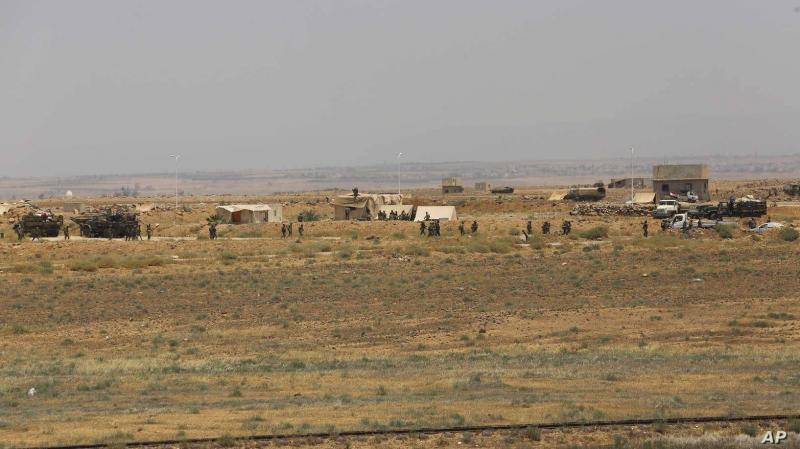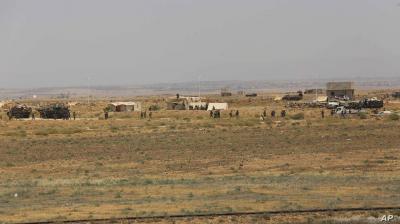After three years of an exceptional settlement sponsored by Russia in Daraa in southern Syria, the province has recently witnessed a military escalation between Syrian forces and opposition armed groups, accompanied by a siege that worsens the humanitarian situation. What has changed today, what is happening in Daraa Province, specifically in the city, and what awaits it?
## What is Unique About Daraa?
Daraa Province, bordering Jordan and Israel, was the cradle of the protests that erupted in 2011 against the Syrian government, sparking protests that soon spread across most of Syria. As the protests escalated into a violent conflict, opposition factions took control of the province. In 2018, after Syrian forces regained key opposition strongholds like Aleppo (north) and Eastern Ghouta (near Damascus), they attempted to advance towards Daraa. However, unlike other opposition strongholds that faced military operations and tight sieges ending in agreements for fighters to evacuate to northern Syria, a Russian-sponsored settlement was reached in Daraa that curtailed military operations. The settlement stipulated that opposition fighters surrender heavy weapons while allowing them to keep light arms and remain in their villages and cities. Syrian forces did not deploy throughout the entire province.
Opposition fighters mainly inhabit the western and southern countryside. The city of Daraa is divided between "Daraa al-Balad," located in the south where fighters are present, and "Daraa Al-Mahatta," which is under government control. The political uniqueness of Daraa, being adjacent to Jordan—aiming to shield its territory from the repercussions of the conflict—and the occupied Golan Heights, where Israel fears the spread of Iranian groups fighting near its sites, played a role in finalizing the settlement with Russian guarantees.
## What is Happening on the Ground?
Throughout three years and despite the settlement agreement, security chaos has dominated Daraa, marked by bombings, shootings against Syrian forces, or assassinations targeting supporters or former opponents, as well as civilians working for government institutions, amidst widespread gun proliferation. Several protests have erupted in the province against the government, the latest being demonstrations in Daraa al-Balad against the presidential elections in May. Protesters raised slogans similar to those chanted a decade ago and rejected the Daraa al-Balad committee's proposal to set up ballot boxes in their neighborhoods. Since 2018, the province has sporadically witnessed clashes between Syrian forces and opposition fighters. At the end of July, clashes broke out in various areas of the province, including the city of Daraa, described as "the fiercest" in three years, according to the Syrian Observatory for Human Rights, which documented the deaths of 32 individuals, including 12 civilians, 11 local fighters, and nine Syrian army personnel. The confrontations lasted for two days, during which government forces advanced into farms surrounding southern Daraa neighborhoods, before the intensity of clashes decreased as negotiations, facilitated by Russia, began aiming to reach an agreement on the evacuation of dozens of fighters from Daraa al-Balad.
Opposition activist Omar Al-Hariri from Daraa stated that despite the reduction in military operations, "government forces conduct movements almost daily, especially at night, to exhaust the fighters who possess only light arms." The government forces have not yet resorted to air power.
## Why Now and What are the Likely Outcomes?
Residents and activists speculate that one reason for the military escalation is Damascus's desire for "revenge" against Daraa, where residents continue to protest against it. Al-Hariri claims, "There are many wanted individuals in Daraa al-Balad by the government...," noting that one of the government's conditions is to evacuate certain individuals from the province and send them north. Concurrently, Russia aims to deploy the "Fifth Legion" in Daraa al-Balad, a Syrian army faction supported by Russia and consisting of former opposition fighters from Daraa. But what does the future hold for Daraa? It seems its residents must make a difficult decision. Al-Hariri mentions, "We are faced with two options: the deployment of the Fifth Legion and Russia curbing Syrian forces, or the latter suddenly launching a wide-scale incursion."
## What About the Humanitarian Situation?
Approximately 24,000 people have fled Daraa al-Balad, which has a population of 55,000, with most seeking refuge in other areas of the city or its outskirts, according to the United Nations Office for the Coordination of Humanitarian Affairs. In recent weeks, Syrian forces have gradually tightened their grip on "Daraa al-Balad." According to the UN, residents now have only one route to cross on foot, exposing them to "strict security checks." Abu Al-Tayeb, a resident of Daraa al-Balad and media activist, explains, "Sometimes only women and children are allowed to cross the road, and sometimes it is completely closed." He indicates a complete cutoff of flour supplies from Daraa al-Balad and that "authorities have cut off water from the main reservoir" amid power outages. He says, "We manage with minimal resources."
In Geneva, UN Special Envoy to Syria Geir Pedersen expressed increasing concern about the developments in southern Syria on Thursday. He noted that "the escalation of hostilities" has caused thousands of civilians to flee, indicating that residents suffer from "a severe shortage of fuel, cooking gas, water, and bread. There is also a lack of necessary medical supplies to treat the injured," describing the situation as "critical."




